2016 Exhibits
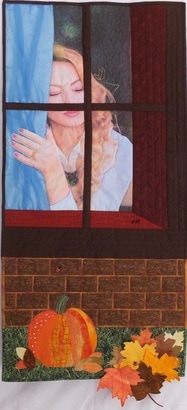 October by Victoria Gray
October by Victoria Gray
Ekphrastic: Quilts & Poetry
Fibre Art Network
October 5 - December 30, 2016
Ekphrastic is a Fibre Art Network of Western Canada (FAN) exhibition scheduled to travel from Oct 2016 to December 2019. The Ekphrastic exhibition is a unique showcase of the collective talents of Canadian poets and fibre artists.
The word ‘Ekphrasis’ means a rhetorical device whereby one medium of art is created to relate to another medium of art. Usually Ekphrastic poetry is created to respond to a piece of art. FAN put a distinctive spin on this process by inviting twelve well known Canadian poets to contribute a poem of their choosing. Each of the twelve poems were interpreted by four FAN members in a wide range of styles, as you can see here with these four images being a response to a poem by Jennifer Still, also titled, October.
Please visit the Fibre Art Network website at http://fibreartnetwork.com/
Fibre Art Network
October 5 - December 30, 2016
Ekphrastic is a Fibre Art Network of Western Canada (FAN) exhibition scheduled to travel from Oct 2016 to December 2019. The Ekphrastic exhibition is a unique showcase of the collective talents of Canadian poets and fibre artists.
The word ‘Ekphrasis’ means a rhetorical device whereby one medium of art is created to relate to another medium of art. Usually Ekphrastic poetry is created to respond to a piece of art. FAN put a distinctive spin on this process by inviting twelve well known Canadian poets to contribute a poem of their choosing. Each of the twelve poems were interpreted by four FAN members in a wide range of styles, as you can see here with these four images being a response to a poem by Jennifer Still, also titled, October.
Please visit the Fibre Art Network website at http://fibreartnetwork.com/
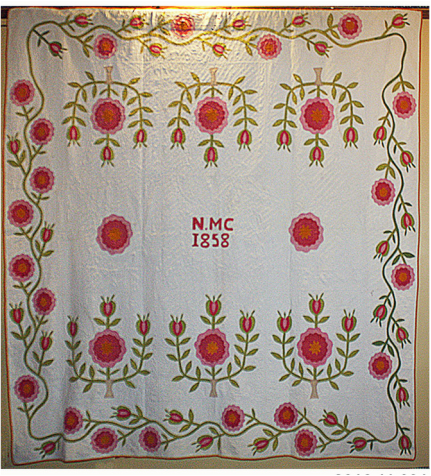 Recent addition to our collection. Made by NMC; dated 1858.
Recent addition to our collection. Made by NMC; dated 1858.
Victorian Christmas & Handmade Dolls
November 23 - December 30, 2016
Open House: Saturday, December 3; free all day
Meet the Artists: Saturday, December 3; 1-3pm
Enjoy the Gaches Mansion dressed for a Victorian Christmas with quilts and textiles from our permanent collection. Explore all three floors decorated with trees and textiles popular during the long reign of Queen Victoria (1837-1901). On display on the first floor will be quilts and textiles dating from the 1840s and into the 1850s including the beautiful hand stitched red & green applique quilt, an 1860s Civil War Album quilt, and quilts from the 1880-90s. Some of the quilts on display are seen at right.
As a special treat, please spend some time in our Landmarks Gallery where you will find handmade dolls by local artists Gloria Burke, Carol Walker (see Flora Dora. below), and Mardi McLaskey. Each artist has their own unique spin on their creations and the work includes everything from sweet sophistication to Prim dolls. We will also be including dolls from our collection.
November 23 - December 30, 2016
Open House: Saturday, December 3; free all day
Meet the Artists: Saturday, December 3; 1-3pm
Enjoy the Gaches Mansion dressed for a Victorian Christmas with quilts and textiles from our permanent collection. Explore all three floors decorated with trees and textiles popular during the long reign of Queen Victoria (1837-1901). On display on the first floor will be quilts and textiles dating from the 1840s and into the 1850s including the beautiful hand stitched red & green applique quilt, an 1860s Civil War Album quilt, and quilts from the 1880-90s. Some of the quilts on display are seen at right.
As a special treat, please spend some time in our Landmarks Gallery where you will find handmade dolls by local artists Gloria Burke, Carol Walker (see Flora Dora. below), and Mardi McLaskey. Each artist has their own unique spin on their creations and the work includes everything from sweet sophistication to Prim dolls. We will also be including dolls from our collection.
 Detail of Edo panels.
Detail of Edo panels.
Images of Japan - Small Works
June 22 - October 2, 2016
The main exhibit is the Path to Edo (Tokyo), depicted from the old picture scroll of the shopfronts in Nihonbashi around 1805. I was prompted to create the shopfronts of Nihonbashi of Edo era after seeing the old streets of Paris in textiles and embroidery. Many of my students participated, took a great deal of effort by checking the storehouses, the river and the order of the shops, and as a result, we were able to create a delightful scene of Nihonbashi. We recently added the merchants, visitors, and others to make it more lively. A Happy Ending!!
Please enjoy the scenes of Japan 200 years ago. We cannot throw away pieces of silk, however small, as they teach us history of Japan. We have joined many to make a bolt of fabric to make a kimono.
Sachiko Yoshida, Guest Curator
This Exhibit made possible in part by sponsorship from:
Ako Shimozato and Glenys Baker.
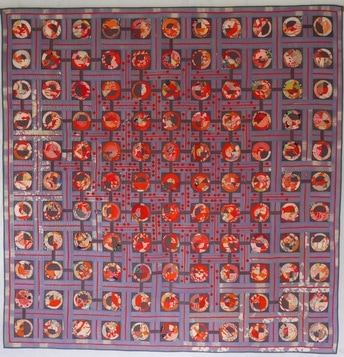 Red and Violet by Sachiko Yoshida.
Red and Violet by Sachiko Yoshida.
Beauty of Japan
June 22 - October 2, 2016
Forty years ago, American patchwork quilts were introduced to many Japanese and the colorful quilts brought much joy to them. When silk was used to make quilts in Japan, it became the Japanese specialty and brought much attention.
The silks we use to make the quilts are from very old kimonos that are taken apart because they could no longer be used as wearables. The pieces of silk are revitalized as patchwork quilts. My students took much time and effort with respect to the fabric to create the quilts.They are original creations with designs, colors, and appliqués of flowers and vegetation.
We appreciate the opportunity La Conner Quilt and Textile Museum has provided us in exhibiting the Japanese quilts. Because of the efforts of the staff and the volunteers of the Museum, many will witness our show and we are deeply grateful.
Sachiko Yoshida, Guest Curator
June 22 - October 2, 2016
Forty years ago, American patchwork quilts were introduced to many Japanese and the colorful quilts brought much joy to them. When silk was used to make quilts in Japan, it became the Japanese specialty and brought much attention.
The silks we use to make the quilts are from very old kimonos that are taken apart because they could no longer be used as wearables. The pieces of silk are revitalized as patchwork quilts. My students took much time and effort with respect to the fabric to create the quilts.They are original creations with designs, colors, and appliqués of flowers and vegetation.
We appreciate the opportunity La Conner Quilt and Textile Museum has provided us in exhibiting the Japanese quilts. Because of the efforts of the staff and the volunteers of the Museum, many will witness our show and we are deeply grateful.
Sachiko Yoshida, Guest Curator
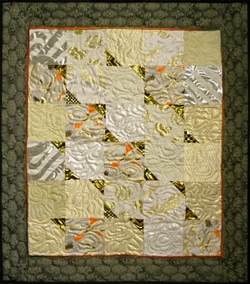 Quilt made with Obi Sash by Reynola Pakusich.
Quilt made with Obi Sash by Reynola Pakusich.
A Quiltmaker's Journey Continues: Quilt Designs with Natural Fibers 2000-2016
Reynola Pakusich
August 31 - October 2, 2016
Reynola Pakusich is a third generation member from a family of quilters who settled in Eastern Washington and Idaho. She began quilting seriously in the 1970's and teaching for quilt shops shortly afterward. She has had numerous photos of her quilts published in books and magazines, as well as several one woman shows. Reynola retired from 30 years of public school teaching in Sedro-Woolley School District and now combines quilting with her husband’s interests of fishing and hunting (i.e. paper piecing in a car, boat, on a ferry or working by gas light at a lake cabin.) Residing in Bellingham, Washington, she is an active member of several Northwest Washington quilt/study groups and continues to take workshops, attend lectures, and experiments with the latest techniques to keep herself on the cutting edge of the craft.
Reynola Pakusich
August 31 - October 2, 2016
Reynola Pakusich is a third generation member from a family of quilters who settled in Eastern Washington and Idaho. She began quilting seriously in the 1970's and teaching for quilt shops shortly afterward. She has had numerous photos of her quilts published in books and magazines, as well as several one woman shows. Reynola retired from 30 years of public school teaching in Sedro-Woolley School District and now combines quilting with her husband’s interests of fishing and hunting (i.e. paper piecing in a car, boat, on a ferry or working by gas light at a lake cabin.) Residing in Bellingham, Washington, she is an active member of several Northwest Washington quilt/study groups and continues to take workshops, attend lectures, and experiments with the latest techniques to keep herself on the cutting edge of the craft.

See Jane Sew Challenge
August 31 - October 2, 2016
At the 2015 Quilt & Fiber Arts Festival, a challenge was issued to create a work of art using two pieces of fabric designed by Jane Sassaman.
Each kit contains two Jane Sassaman fabric fat quarters (donated by Julie Anderson – thank you, Julie!)
August 31 - October 2, 2016
At the 2015 Quilt & Fiber Arts Festival, a challenge was issued to create a work of art using two pieces of fabric designed by Jane Sassaman.
Each kit contains two Jane Sassaman fabric fat quarters (donated by Julie Anderson – thank you, Julie!)
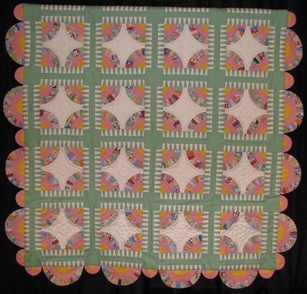 Rocky Mountain Springtime by Sherry Burkhalter
Rocky Mountain Springtime by Sherry Burkhalter
Colonial Revival Quilts
American Quilt Study Group
June 1 - August 28, 2016
The biennial Quilt Studies have become a popular part of the American Quilt Study Group’s activities. Participation is a voluntary undertaking by AQSG members. Responding to a selected theme, a quilt is created which is copied from, or inspired by, an existing antique quilt. Each Participant is asked to provide an image of their inspiration and write a statement describing why they chose the inspiration quilt; the techniques used to construct their own quilt; and what was learned in the process.
This 2012 Quilt Study theme was Colonial Revival Quilts from the Early 20th Century. All inspiration quilts are required to be recognizable as quilts from the period regardless of the techniques used to make the original quilt. It is up to each Participant to determine their own construction methods for their projects based upon information available about the original quilt.
All of the completed Study Quilts are exhibited at AQSG Seminar at which time we ask three AQSG members to serve as a selection committee. Their task is to determine which of the study quilts will travel throughout the United States for approximately two years.
American Quilt Study Group
June 1 - August 28, 2016
The biennial Quilt Studies have become a popular part of the American Quilt Study Group’s activities. Participation is a voluntary undertaking by AQSG members. Responding to a selected theme, a quilt is created which is copied from, or inspired by, an existing antique quilt. Each Participant is asked to provide an image of their inspiration and write a statement describing why they chose the inspiration quilt; the techniques used to construct their own quilt; and what was learned in the process.
This 2012 Quilt Study theme was Colonial Revival Quilts from the Early 20th Century. All inspiration quilts are required to be recognizable as quilts from the period regardless of the techniques used to make the original quilt. It is up to each Participant to determine their own construction methods for their projects based upon information available about the original quilt.
All of the completed Study Quilts are exhibited at AQSG Seminar at which time we ask three AQSG members to serve as a selection committee. Their task is to determine which of the study quilts will travel throughout the United States for approximately two years.
 Young Lady in Bloom by Janet King. Image by Michael Stadler of Stadler Studios.
Young Lady in Bloom by Janet King. Image by Michael Stadler of Stadler Studios.
That's How We Felt!
August 3 - 28, 2016
The oldest form of making fabric, contemporary felters have taken this art form in a whole new direction. Taking loose fibers and manipulating these fibers through various processes the artists can create a flat surfaces, 3-Dimensional, and even garments.
Artists
Fine Gelfand, Zia Gipson, Amy Green, Carys Hamer, Cheryl Kamera, Janet King, Bobbi Lauducci, Lois Pendleton, Ilene Sorenson
Many thanks to Zia Gipson for help in organizing this exhibit.
August 3 - 28, 2016
The oldest form of making fabric, contemporary felters have taken this art form in a whole new direction. Taking loose fibers and manipulating these fibers through various processes the artists can create a flat surfaces, 3-Dimensional, and even garments.
Artists
Fine Gelfand, Zia Gipson, Amy Green, Carys Hamer, Cheryl Kamera, Janet King, Bobbi Lauducci, Lois Pendleton, Ilene Sorenson
Many thanks to Zia Gipson for help in organizing this exhibit.
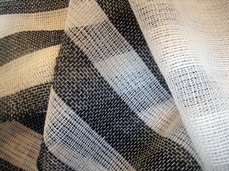 Black and White Weaving (detail) by Mary Burks.
Black and White Weaving (detail) by Mary Burks.
Weaving Exhibit
July 6 - 31, 2016
Today, most of our textile needs are supplied with commercially woven cloth. However, there are still artisans making cloth on hand looms, in home studios, or small weaving businesses, keeping alive the skills and traditions of the early weavers.
Assistant Guest Curator, Val Gleeson
July 6 - 31, 2016
Today, most of our textile needs are supplied with commercially woven cloth. However, there are still artisans making cloth on hand looms, in home studios, or small weaving businesses, keeping alive the skills and traditions of the early weavers.
Assistant Guest Curator, Val Gleeson
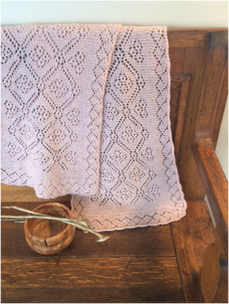 Stonecrop by Kelli Wyll
Stonecrop by Kelli Wyll
Creative Knitting
June 1 - July 3, 2016
Carol Harrington, Assistant Guest Curator
Take a glimpse into the world of creative knitting. Hand knitting is most often done using yarn and knitting needles to create an interlocked fabric and that is where the fun begins. Manipulating the yarn allows the knitter to vary the stitching to include colorful patterns, lacy edgings, and even beadwork. At times, knitting is used as a wearable item but may also be used as an element on a finished garment. Working with commercial or original designs, the work reflects the artists’ choice of yarn, stitch patterns, embellishment or other modifications that reflect their creative spirit.
June 1 - July 3, 2016
Carol Harrington, Assistant Guest Curator
Take a glimpse into the world of creative knitting. Hand knitting is most often done using yarn and knitting needles to create an interlocked fabric and that is where the fun begins. Manipulating the yarn allows the knitter to vary the stitching to include colorful patterns, lacy edgings, and even beadwork. At times, knitting is used as a wearable item but may also be used as an element on a finished garment. Working with commercial or original designs, the work reflects the artists’ choice of yarn, stitch patterns, embellishment or other modifications that reflect their creative spirit.
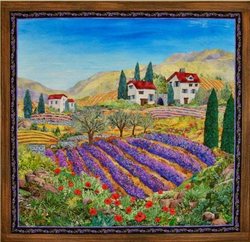 Poppies of Provence by Kathy McNeil
Poppies of Provence by Kathy McNeil
A Magical Journey of Hand Appliqué
Kathy McNeil
March 30 - June 19, 2016
My work is traditional in technique, and pictorial in style. My quilt tops begin as a sketch, which I enlarge to the size of the finished quilt. About 75% of the finished quilt will resemble the sketch as I work out each little area or character, listening to the fabric and how it can best reveal the heart and soul of the piece. Hand appliqué is my technique of choice. All my edges are turned under and appliquéd, usually with silk thread. I love the rhythm and serenity it gives me. I love being able to easily rip it out when a new idea or inspiration carries me away. I love honoring the generations of women who have gone before me and share this passion.
Kathy McNeil
March 30 - June 19, 2016
My work is traditional in technique, and pictorial in style. My quilt tops begin as a sketch, which I enlarge to the size of the finished quilt. About 75% of the finished quilt will resemble the sketch as I work out each little area or character, listening to the fabric and how it can best reveal the heart and soul of the piece. Hand appliqué is my technique of choice. All my edges are turned under and appliquéd, usually with silk thread. I love the rhythm and serenity it gives me. I love being able to easily rip it out when a new idea or inspiration carries me away. I love honoring the generations of women who have gone before me and share this passion.
 Circles of Life by Anita Luvera Mayer
Circles of Life by Anita Luvera Mayer
Clothing: Art & Embellishment
Anita Luvera Mayer
March 30 - June 19, 2016
This exhibition presents a collection of garments created during the past three years that speaks to my personal journey as a woman of eighty-three years. Every woman has a story and I believe growing older is an adventure unlike any other and that philosophy is the inspiration of my work. Making clothing is my passion and I want to celebrate my life and my years with what I wear. I don't believe in age-appropriate dress but want to make a personal statement about who I am and what I cherish.
This collection honors the women before me, the magical places I have traveled and the importance of celebrating the moment. I want to age with independence, dignity and purpose and wear clothing that represents that philosophy.
It is who I am.
Images by KP-Studios.com
Anita Luvera Mayer
March 30 - June 19, 2016
This exhibition presents a collection of garments created during the past three years that speaks to my personal journey as a woman of eighty-three years. Every woman has a story and I believe growing older is an adventure unlike any other and that philosophy is the inspiration of my work. Making clothing is my passion and I want to celebrate my life and my years with what I wear. I don't believe in age-appropriate dress but want to make a personal statement about who I am and what I cherish.
This collection honors the women before me, the magical places I have traveled and the importance of celebrating the moment. I want to age with independence, dignity and purpose and wear clothing that represents that philosophy.
It is who I am.
Images by KP-Studios.com
 Oval Applique with Hexies by Glenys Baker
Oval Applique with Hexies by Glenys Baker
Hexies & More...
Glenys Baker in the Landmarks Gallery
May 4 - 29, 2016
Moving to Ohio 25 years ago from Wales, UK and unable to work without a Green Card, I took up quilting and volunteer work to fill the days while my husband was working. When I did get a Green Card I was too busy to work.
Ohio had an excellent quilting community and I was able to learn various quilting techniques focusing on hand applique. A nearby Amish community was also an inspiration with their handwork and hand quilting.
When my husband retired and we relocated to Bellingham, I found the quilting scene in Washington to be just as active. More recently I have enjoyed the handwork of piecing hexagon quilts.
Volunteering at La Conner Quilt Museum has given me access to a great variety of quilting inspiration and a great team to work with. I consider myself a ‘hobby quilter’ and have taken various classes at the museum to increase my skill level.
It is an honor to be asked to show my hexagon quilts at the museum and I would like to thank Dani Fisk of Blaine for doing the beautiful machine quilting on several of the quilts.
Glenys Baker in the Landmarks Gallery
May 4 - 29, 2016
Moving to Ohio 25 years ago from Wales, UK and unable to work without a Green Card, I took up quilting and volunteer work to fill the days while my husband was working. When I did get a Green Card I was too busy to work.
Ohio had an excellent quilting community and I was able to learn various quilting techniques focusing on hand applique. A nearby Amish community was also an inspiration with their handwork and hand quilting.
When my husband retired and we relocated to Bellingham, I found the quilting scene in Washington to be just as active. More recently I have enjoyed the handwork of piecing hexagon quilts.
Volunteering at La Conner Quilt Museum has given me access to a great variety of quilting inspiration and a great team to work with. I consider myself a ‘hobby quilter’ and have taken various classes at the museum to increase my skill level.
It is an honor to be asked to show my hexagon quilts at the museum and I would like to thank Dani Fisk of Blaine for doing the beautiful machine quilting on several of the quilts.
 Duck and Ducklings Quilt, c.1900
Duck and Ducklings Quilt, c.1900
Piece by Piece: Quilts of the Early 20th Century
March 30 - May 29, 2016
Piece by Piece – Quilts of the early 20th Century
Quiltmaking in urban areas slows down during the last decade of the 19th .The Crazy Quilt fad of making highly decorative embellished silk quilts was diminishing and readymade blankets were inexpensive to purchase. Still, quiltmaking remains popular in rural areas and cotton became the desired fabric choice for quilts. At the end of the 19th century, colors available for quilts were somber. The first successful black dye for cotton was in the 1890s--wine, navy, black, gray, red, and blue round out the color choices. But a lighter color scheme was about to take hold.
March 30 - May 29, 2016
Piece by Piece – Quilts of the early 20th Century
Quiltmaking in urban areas slows down during the last decade of the 19th .The Crazy Quilt fad of making highly decorative embellished silk quilts was diminishing and readymade blankets were inexpensive to purchase. Still, quiltmaking remains popular in rural areas and cotton became the desired fabric choice for quilts. At the end of the 19th century, colors available for quilts were somber. The first successful black dye for cotton was in the 1890s--wine, navy, black, gray, red, and blue round out the color choices. But a lighter color scheme was about to take hold.
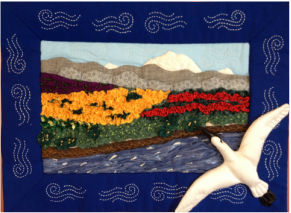
La Conner In Bloom
March 30 - May 1, 2016
The La Conner Quilt & Textile Museum has issued a Challenge to use the phrase "Flights of Fancy" as your inspiration in a small fiber art piece. We got some wonderful pieces submitted and many of them are available for sale!
March 30 - May 1, 2016
The La Conner Quilt & Textile Museum has issued a Challenge to use the phrase "Flights of Fancy" as your inspiration in a small fiber art piece. We got some wonderful pieces submitted and many of them are available for sale!
 Hearts Delight by Donna Hanson Eines
Hearts Delight by Donna Hanson Eines
Traditional Quilts - Hand Quilting & Trapunto
Donna Hanson Eines
January 6 - March 27, 2016
Donna Hanson Eines, a native of Seattle, Washington, began quilting in 1974, and entered her first quilt, (Cathedral Window) in the 1975 Island County Fair in Langley, Washington, Imagine her surprise when that first quilt was awarded a beautiful Best of Show ribbon and an engraved silver plate. This launched the beginning of Donna’s prolific quilting career, and in the years since that first Best of Show in Island County Fair, she has won numerous best in show awards, and created an extraordinary collection of quilts of all sizes and styles.
Donna’s quilts have also appeared in national magazines, including Quilter’s Newsletter, Quilt World, Good Housekeeping, Quilting Today, and Ladies Circle Patchwork Quilts, with several publications featuring cover photos of her quilts. Additionally, Donna’s quilts have appeared in numerous books, including several published by That Patchwork Place, The Quilt Digest, Powel Publications, Weaver-Finch Publications, and Oxmoor House.
Donna Hanson Eines
January 6 - March 27, 2016
Donna Hanson Eines, a native of Seattle, Washington, began quilting in 1974, and entered her first quilt, (Cathedral Window) in the 1975 Island County Fair in Langley, Washington, Imagine her surprise when that first quilt was awarded a beautiful Best of Show ribbon and an engraved silver plate. This launched the beginning of Donna’s prolific quilting career, and in the years since that first Best of Show in Island County Fair, she has won numerous best in show awards, and created an extraordinary collection of quilts of all sizes and styles.
Donna’s quilts have also appeared in national magazines, including Quilter’s Newsletter, Quilt World, Good Housekeeping, Quilting Today, and Ladies Circle Patchwork Quilts, with several publications featuring cover photos of her quilts. Additionally, Donna’s quilts have appeared in numerous books, including several published by That Patchwork Place, The Quilt Digest, Powel Publications, Weaver-Finch Publications, and Oxmoor House.
 I.C. Chameleon by Fine Gelfand
I.C. Chameleon by Fine Gelfand
Beyond the Surface
Whidbey Island Surface Design Association
January 6 - March 27, 2016
Beyond the Surface includes artwork using fiber and fabric as the basis for the work. Each artist has their own unique style and the process used to accomplish their work is as varied as the individual piece. Techniques include: dyeing, wrapping, felting, stitching, weaving, image transfer, beading, quilting, painting, printing, and collage.
Art quilter Janet Steadman’s piece, Branchlets, features amazing piecework that is combined with meticulous machine quilting. Other artists working with fabric may also include hand work, such as the work by Carol Barton Jerome and Bergen Rose; who add hand stitched details to enhance their work.
Working with paper, Marie Plakos has created Ceremonial Vessel, a 3-D sculpture made of cast paper. Criss Cross, by feltmaker Zia Gipson, was made using the Korean paper felting technique called, Joomchi; creating a unique layered paper art piece. Janet King and Ilene Rae Sorenson have created dimensional pieces using felted wool. Basket makers, Danielle Bodine and Nancy Loorem-Adams, are working with traditional basket making fibers, but then use other elements such as mulberry paper, clay, or feathers to finish their work. Another artist working in 3-D is Larkin Jean Van Horn however she is using beading to create her work.
Chameleon, by wearable artist Fine Gelfand, was created using sheer fabrics to encapsulate elements, with added sequins and threadwork to enhance the details. Cheryl Kamera and Kristin Lasher use hand-dyeing techniques when making their garments.
The Museum welcomes the following artists for this exhibit, the third by the group: Liz Axford, Danielle Bodine, Mary Burks, Debra Calkins, Fine Gelfand, Zia Gipson, Carol Barton Jerome, Cheryl Kamera, Janet King, Patricia King, Barbara Kuznetz, Kristin Lasher, Nan Leaman, Nancy Loorem-Adams, Pat Morse, Natalie Olsen, Marie Plakos, Diane Reardon, Bergen Rose, Laura Stangel Schmidt, Ilene Rae Sorenson, Janet Steadman, Larkin Jean Van Horn, Sande Wascher-James, and Colleen Wootton
To view more of the artists’ work, visit their blog at www.whidbeyislandsda.wordpress.com
Whidbey Island Surface Design Association
January 6 - March 27, 2016
Beyond the Surface includes artwork using fiber and fabric as the basis for the work. Each artist has their own unique style and the process used to accomplish their work is as varied as the individual piece. Techniques include: dyeing, wrapping, felting, stitching, weaving, image transfer, beading, quilting, painting, printing, and collage.
Art quilter Janet Steadman’s piece, Branchlets, features amazing piecework that is combined with meticulous machine quilting. Other artists working with fabric may also include hand work, such as the work by Carol Barton Jerome and Bergen Rose; who add hand stitched details to enhance their work.
Working with paper, Marie Plakos has created Ceremonial Vessel, a 3-D sculpture made of cast paper. Criss Cross, by feltmaker Zia Gipson, was made using the Korean paper felting technique called, Joomchi; creating a unique layered paper art piece. Janet King and Ilene Rae Sorenson have created dimensional pieces using felted wool. Basket makers, Danielle Bodine and Nancy Loorem-Adams, are working with traditional basket making fibers, but then use other elements such as mulberry paper, clay, or feathers to finish their work. Another artist working in 3-D is Larkin Jean Van Horn however she is using beading to create her work.
Chameleon, by wearable artist Fine Gelfand, was created using sheer fabrics to encapsulate elements, with added sequins and threadwork to enhance the details. Cheryl Kamera and Kristin Lasher use hand-dyeing techniques when making their garments.
The Museum welcomes the following artists for this exhibit, the third by the group: Liz Axford, Danielle Bodine, Mary Burks, Debra Calkins, Fine Gelfand, Zia Gipson, Carol Barton Jerome, Cheryl Kamera, Janet King, Patricia King, Barbara Kuznetz, Kristin Lasher, Nan Leaman, Nancy Loorem-Adams, Pat Morse, Natalie Olsen, Marie Plakos, Diane Reardon, Bergen Rose, Laura Stangel Schmidt, Ilene Rae Sorenson, Janet Steadman, Larkin Jean Van Horn, Sande Wascher-James, and Colleen Wootton
To view more of the artists’ work, visit their blog at www.whidbeyislandsda.wordpress.com
 Crazy Quilt by Annie Pickens Mehrhof and friends.
Crazy Quilt by Annie Pickens Mehrhof and friends.
A Stitch Here, a Stitch There
Quilts from the Permanent Collection
January 6 - March 27, 2016
We start each new year with a selection of embellished quilts. One style of hand embellished quilts includes Crazy Quilts, a fad that started around the 1880's when American quilters picked up needle and thread to create these highly embellished quilts. The style usually features random-sized patches sewn onto a foundation fabric but a few might include fans or other recognizable patterns. The edges of the patches are often covered with embroidery stitches. Sometimes the patches may include paintings, ink work, or additional embroidery work. At left, Crazy Quilt, Annie Pickens Mehrhof and her friends, dated 1885.
Quilts from the Permanent Collection
January 6 - March 27, 2016
We start each new year with a selection of embellished quilts. One style of hand embellished quilts includes Crazy Quilts, a fad that started around the 1880's when American quilters picked up needle and thread to create these highly embellished quilts. The style usually features random-sized patches sewn onto a foundation fabric but a few might include fans or other recognizable patterns. The edges of the patches are often covered with embroidery stitches. Sometimes the patches may include paintings, ink work, or additional embroidery work. At left, Crazy Quilt, Annie Pickens Mehrhof and her friends, dated 1885.
 Medieval Scene, detail, by Elise Olsen. La Conner Quilt & Textile Permanent Collection.
Medieval Scene, detail, by Elise Olsen. La Conner Quilt & Textile Permanent Collection.
Needlepoint Guild of Anacortes
March 2 - 27, 2016
What is Needlepoint? Traditionally, needlepoint has been embroidery done on canvas, using wool to execute the tent stitch. While such embroideries are needlepoint, today’s needlepointer has available a much broader palette of stitches and techniques.
American Needlepoint Guild defines needlepoint as "any counted or free stitchery worked by hand with a threaded needle on a readily countable ground." This progressive definition encourages creativity through a traditional and contemporary approach to needlepoint.
Meet local needlepoint artists and see their amazing, hand-stitched work. The Anacortes Guild is a chapter of the larger Needlepoint Guild of America Incorporated. Also on display will be needlepoint pieces from our permanent collection.
Assistant Guest Curator, Diane Brosten.
To learn more about the American Needlepoint Guild Inc., click here
March 2 - 27, 2016
What is Needlepoint? Traditionally, needlepoint has been embroidery done on canvas, using wool to execute the tent stitch. While such embroideries are needlepoint, today’s needlepointer has available a much broader palette of stitches and techniques.
American Needlepoint Guild defines needlepoint as "any counted or free stitchery worked by hand with a threaded needle on a readily countable ground." This progressive definition encourages creativity through a traditional and contemporary approach to needlepoint.
Meet local needlepoint artists and see their amazing, hand-stitched work. The Anacortes Guild is a chapter of the larger Needlepoint Guild of America Incorporated. Also on display will be needlepoint pieces from our permanent collection.
Assistant Guest Curator, Diane Brosten.
To learn more about the American Needlepoint Guild Inc., click here
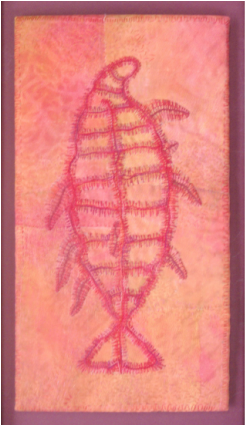 Long Narrows Salmon
by Anne Middleton
Long Narrows Salmon
by Anne Middleton
Embroidered Fiber Art
Anne Middleton
February 3 - 28, 2016
Local fiber artist, Anne Middleton's hand stitched work has been focused on Northwest Rock Art; her recent work features petroglyphs and pictographs.
Anne’s long fiber history began at her father’s knee– a man who saved string, cord, and leather – who hand-repaired saddles, harnesses, bags, and other heavy stitched gear. Anne’s grandmother was a quilter, also stitching by hand, making intricate embroidered designs to join crazy quilt panels passed down in her family. Yet a third creative thread came through Anne’s mother, a painter of furniture designs in Los Angles’ international district in the 20s and 30s.
Anne began taking textile classes with Anita Luvera Mayer and others, and upon retiring, was fortunate to study the art of hand-stitching at Gail Harker’s Center for Creative Arts, completing the 200-level Creative Hand-Stitch course. During this time, Anne came upon the fascinating images of Northwest rock art, both petroglyphs (etched) and pictographs (painted). Using these designs provided for her the perfect melding of textile art and cultural anthropology. She feels it is an honor to share these striking but not-so-well-known motifs through her work.
Anne Middleton
February 3 - 28, 2016
Local fiber artist, Anne Middleton's hand stitched work has been focused on Northwest Rock Art; her recent work features petroglyphs and pictographs.
Anne’s long fiber history began at her father’s knee– a man who saved string, cord, and leather – who hand-repaired saddles, harnesses, bags, and other heavy stitched gear. Anne’s grandmother was a quilter, also stitching by hand, making intricate embroidered designs to join crazy quilt panels passed down in her family. Yet a third creative thread came through Anne’s mother, a painter of furniture designs in Los Angles’ international district in the 20s and 30s.
Anne began taking textile classes with Anita Luvera Mayer and others, and upon retiring, was fortunate to study the art of hand-stitching at Gail Harker’s Center for Creative Arts, completing the 200-level Creative Hand-Stitch course. During this time, Anne came upon the fascinating images of Northwest rock art, both petroglyphs (etched) and pictographs (painted). Using these designs provided for her the perfect melding of textile art and cultural anthropology. She feels it is an honor to share these striking but not-so-well-known motifs through her work.
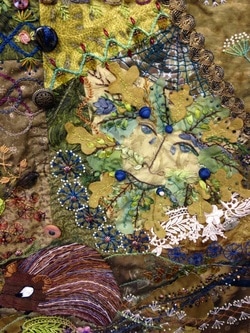 Crazy Quilt detail by JaNita Clairmont
Crazy Quilt detail by JaNita Clairmont
Crazy Quilts
JaNita Clairmont
January 6 - 31, 2016Local Crazy Quilt artist, JaNita Clairmont, creates wonderful, whimiscal quilts. Each a unique work of art, JaNita uses fabric, lace, thread, and beads to bring her work to life.
I started quilting in 1976 with the Bi-centennial resurgence in quilting and traditional crafts. Like so many, I started out with a sampler quilt and worked my way through Log Cabins, Attic Windows and I really thought I was special when I made my first Mariner's Compass! I joined a local Guild and 17 years ago, started teaching.
JaNita Clairmont
January 6 - 31, 2016Local Crazy Quilt artist, JaNita Clairmont, creates wonderful, whimiscal quilts. Each a unique work of art, JaNita uses fabric, lace, thread, and beads to bring her work to life.
I started quilting in 1976 with the Bi-centennial resurgence in quilting and traditional crafts. Like so many, I started out with a sampler quilt and worked my way through Log Cabins, Attic Windows and I really thought I was special when I made my first Mariner's Compass! I joined a local Guild and 17 years ago, started teaching.


